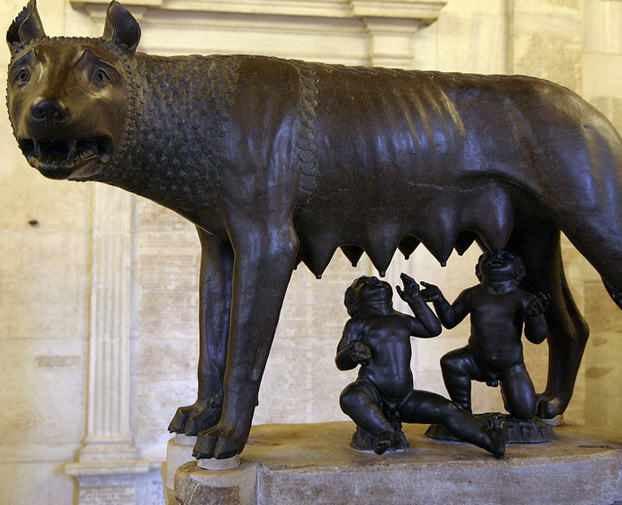
© Marcin Floryan/Wikimedia CommonsThe Capitoline she wolf.
The icon of Rome's foundation, a life-size bronze statue of a she-wolf with two human infants suckling her, is about 1,700 years younger than its city, Rome's officials admitted on Saturday.
The official announcement, made at the
Capitoline Museums, where the 30 inch-high bronze is the centerpiece of a dedicated room, quashes the belief that the sculpture was adopted by the earliest Romans as a symbol for their city.
"The new dating ranges between 1021 e il 1153," said Lucio Calcagnile, who carried radiocarbon tests at the University of Salento's Center for Dating e Diagnostics.
Recalling the story of a she-wolf which fed Romulus, the legendary founder of Rome, and his twin brother, Remus, after they had been thrown in a basket into the Tiber River, the so called "Lupa Capitolina" (Capitoline she-wolf) was donated to the museum in 1471 by Pope Sixtus IV.
The sculpture was thought to be either the product of an Etruscan workshop in the 5th century B.C. or the masterpiece of the 6th century B.C. Etruscan sculptor Vulca of Veii.
Considered the archetypal symbol of Rome, as potent as the Colosseum, St Peter's Basilica and the Trevi Fountain, the Capitoline she-wolf was used in the poster of the 1960 Rome Olympics and is one of the most popular items among souvenir sellers in Rome.
With her defiant stance and raised eyebrows, the Lupa Capitolina was also one of the favored images of Benito Mussolini, the fascist dictator, who considered himself the founder of the New Rome.
Scholars had long established that the bronze figures of Romulus and Remus were added in the Renaissance, in accordance to the legend of Rome's foundation. Yet the sculture's link to antiquity wasn't seriously questioned until the 1997 restoration.
At that time, restorer Anna Maria Carruba noticed that the she-wolf was cast as a single unit, a technique typically used in the Middle Ages.
On the contrary, ancient bronzes were cast in separate parts, and then brazed together. First used by the Greeks and then adopted by Etruscan and Roman artists, the technique basically consisted of brazing the separate joints using bronze as welding material.
After much discussion, Rome's officials decided to carry more in-depth tests to clear any doubt.
Using accelerator mass spectrometry, the researchers extracted, analyzed and radiocarbon dated organic samples from the casting process. The results revealed with an accuracy by 95,4 percent that the sculpture was crafted between the 11th and 12th century AD.
"The new thesis is that it is a medieval copy of an original Etruscan work," Rome's municipality supervisor for culture, Umberto Broccoli, said.
He remarked that the Etruscan attribution was first made by 18th-century German art historian Johann Joachim Winckelmann on the basis of how the wolf's fur was represented.
"From Winckelmann onward, scholars have debated on the scultpure's dating. In my opinion, we will never have a definitive answer," Broccoli said.
"However, the latest study had brought much more clarity," he admitted.

Reader Comments
to our Newsletter